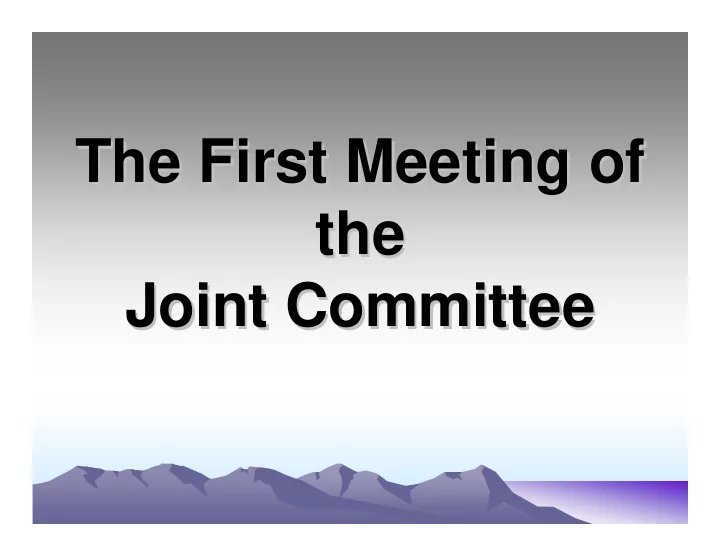

The First Meeting of The First Meeting of the the Joint Committee Joint Committee
First Report of the Joint Committee---1970 The Committee found that the reported results of mass behavioral screening programs are inconsistent and misleading, and recommended intensive study of a number of variables and urged increased research efforts.
Second Report of the Joint Committee---1972 New information that the application of high risk data can increase the detectability of congenital hearing impairment compels a recommendation that infants AT RISK for hearing impairment should be identified, tested, and followed up.
Importance of These Two Reports On the basis of the Ewings Ewings noisemaker tests in England, a noisemaker tests in England, a • On the basis of the • “”Distraction Test Distraction Test’ ’ using noisemakers and subjective observations using noisemakers and subjective observations “” was begun in England in 1950,administered by nurses to children was begun in England in 1950,administered by nurses to children 7- -8months of age and was nationalized by law. Other European 8months of age and was nationalized by law. Other European 7 countries espoused this technique, and it became so firmly countries espoused this technique, and it became so firmly embedded that long after the U.S. was using electro- - embedded that long after the U.S. was using electro physiological methods to test newborn the other countries were physiological methods to test newborn the other countries were still using the behavioral technique. still using the behavioral technique. The Joint Committee’ ’s rejection of behavioral testing gave us a s rejection of behavioral testing gave us a • The Joint Committee • ten- -year lead on other countries in using year lead on other countries in using Electro Electro- -physiological physiological ten techniques for valid newborn hearing screening. techniques for valid newborn hearing screening.
High Risk Categories 1972 • History of hereditary childhood hearing impairment • Rubella or other nonbacterial intrauterine fetal infection (CMV, Herpes) • Defects of ear, nose or throat, malformed, Low-set or absent pinna, cleft lip. • Birthweight less than 1500 grams • Bilirubin level greater than 20 mg/100ml serum
1972-1982 • In meeting during the next ten years the Committee expanded the High Risk Register as it also expanded its membership. • The additional risk categories included such items as Bacterial Meningitis and Severe Asphyxia
Historical Statement of 1982 • The committee recommended that infants manifesting any item on the risk criteria list should be screened by the observation of behavioral or ELECTRO-PHYSIOLOGICAL RESPONSE TO SOUND. The statement’s importance was that it encouraged the new physiologic screening and allowed the U.S. investigators to focus on ABR screening rather than behavioral. • Ten years of investigatory time was saved by this statement, and behavioral screening became a part of the past.
Statement of 1990 • The committee not only recommended screening with ABR, but described the acoustic stimulus, pass criteria, and adequate transducers that should be used. • Further High Risk categories were recommended: Stigmata or other findings associated with a syndrome known to include S/N Hearing loss; Prolonged mechanical ventilation for a duration equal to or greater than 10 days (e.g., persistent pulmonary hypertension).
Statement of 1994 •Finally, the committee recommended the Finally, the committee recommended the • hearing screening of ALL infants at birth. hearing screening of ALL infants at birth. •Studies had shown that only 50% of all Studies had shown that only 50% of all • hearing losses were being identified by The hearing losses were being identified by The High Risk Register. High Risk Register. •The new instrument of The new instrument of Oto Oto- -acoustic acoustic • Emissions was added to the ABR as an Emissions was added to the ABR as an acceptable tool. acceptable tool.
Millennium Statement Of 2000 • The committee recognized the “Consensus Statement on Early Identification of Hearing Impairment in Infants and Young Children”, issued in 1993 by the NINDC, concluding that universal hearing screening should be implemented for all infants within the first 3 months of life, using both OAE and ABR screening. • The committee then proceeded to endorse an exemplary system of early hearing detection and intervention. • This document enunciated superb principles of intervention for hearing impaired infants, providing ultimate guidelines that were utilized throughout the country.
Most Recent Statement Most Recent Statement 2007 2007 A MASTERPIECE OF EXPOSITION TO SERVE AS GUIDELINES FOR THE ENTIRE EHDI PROGRAM
Spin- -offs Of Newborn offs Of Newborn Spin Screening Screening • Prediction of SIDS with right ear TOAE abnormality • Findings of unilateral hearing loss problems • Finding of Auditory Neuropathy/Disynchrony • Piggy-backing Genetic tests • Piggy-backing CMV tests
Recommend
More recommend